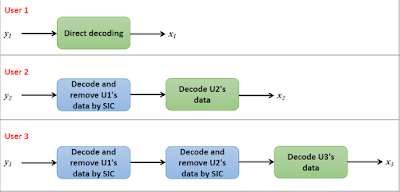NOMA vs OMA - Capacity comparison

As a candidate multiple access technology for 5G, non-orthogonal multiple access (NOMA) offers greater transmission capacity than current orthogonal multiple access (OMA) techniques. This increase in achievable rate is possible because NOMA allows simultaneous transmission of multiple user data in the same frequency carrier. At the transmitter end, the users are multiplexed in the power domain by using superposition coding . At the receiver end, successive interference cancellation (SIC) is carried out to remove interference and to separate the individual user messages. In this post, we will compare the achievable rate offered by NOMA and OMA schemes. Download the MATLAB code here System model Let's consider a downlink communication scenario with a base station (BS) and $N$ users. Let $h_i$, denote the channel from the BS to the $i^{th}$ user. There are $N$ such channels, $h_1$, $h_2$, ... $h_N$. Let us assume that user 1, with...





